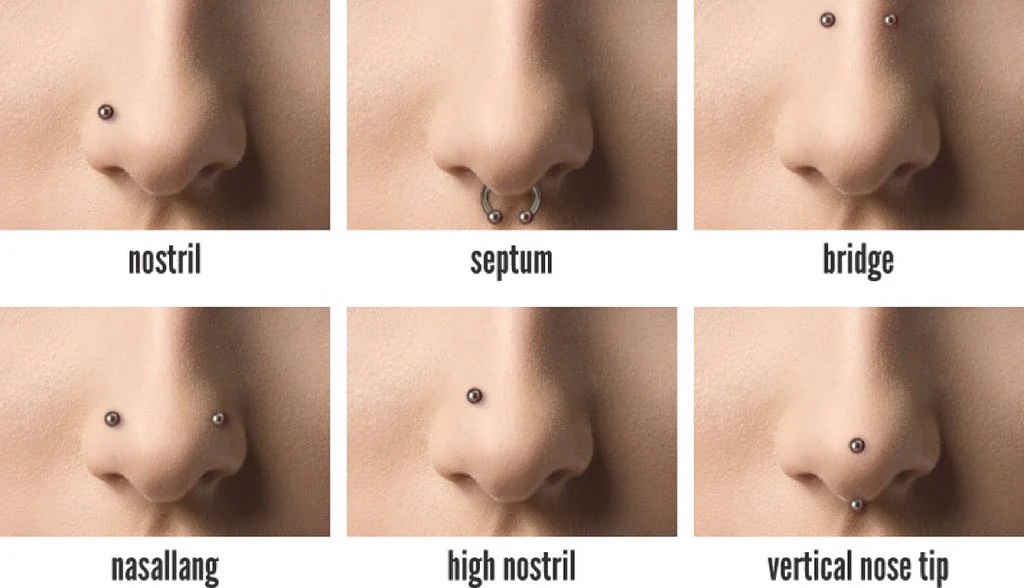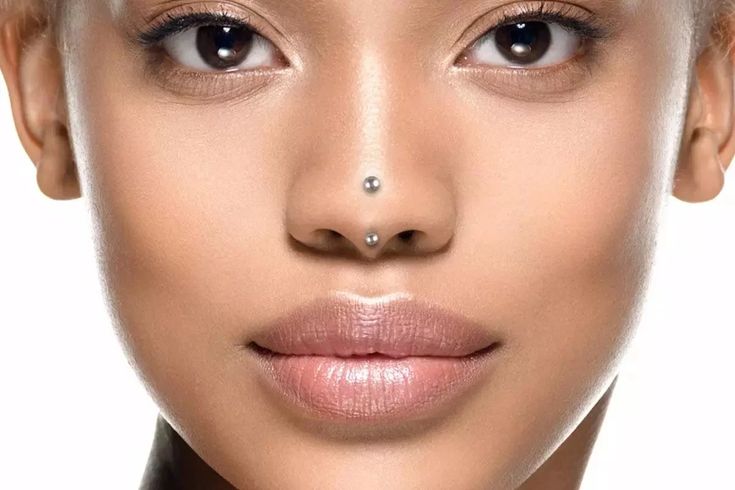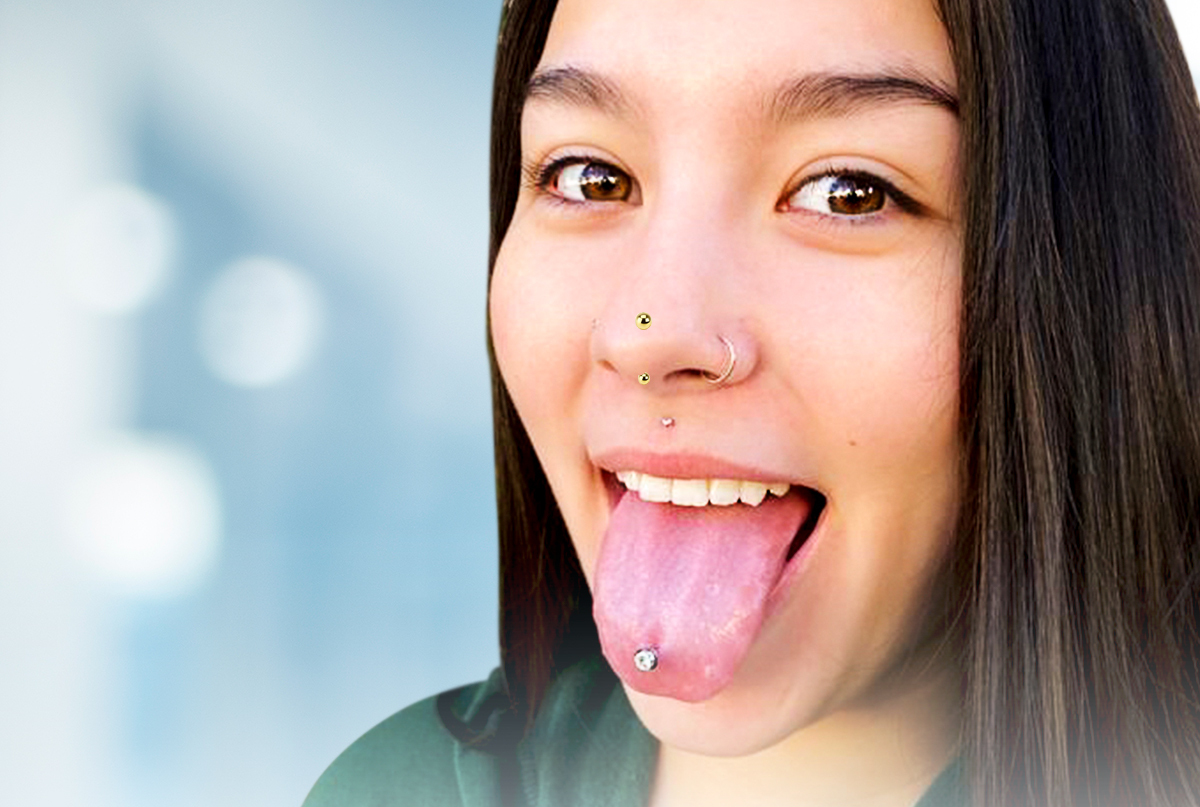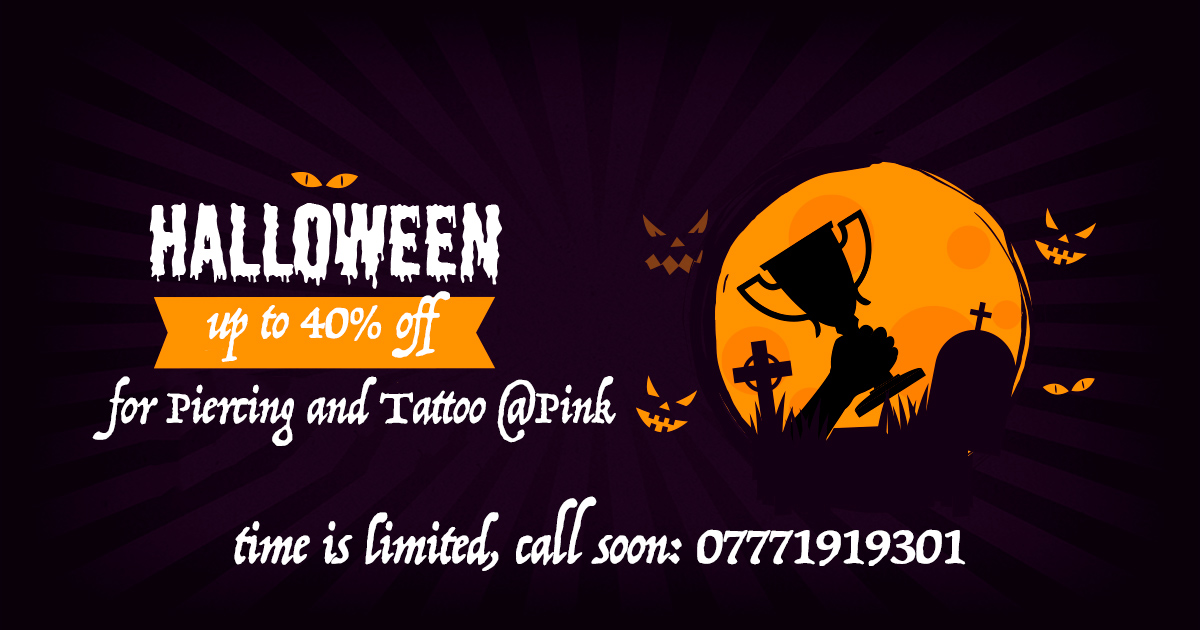In the vast and creative landscape of facial piercings, where self-expression takes countless forms, there exist certain placements that are not merely decorative, but legendary. These are piercings that speak of deep commitment, anatomical rarity, and the pinnacle of a piercer’s skill. The rhino piercing sits firmly in this elite category. Named for its striking resemblance to a rhinoceros horn, this powerful vertical piercing travels directly through the tip of the nose, from the soft tissue just above the septum to emerge from the upper surface of the nasal tip. It is a piercing of pure symmetry and verticality, a bold line that interrupts the horizontal planes of the face, drawing focus to the eyes and creating a statement of undeniable confidence. It is, without exaggeration, a true collector’s piece for the most serious and dedicated body art enthusiast.
However, the rhino piercing’s profound rarity is not due to a lack of aesthetic appeal, but rather to its extreme technical difficulty and the stringent anatomical requirements for its success. This is arguably one of the most advanced and high-risk piercings a person can get, and as such, it must be approached with the immense respect, caution, and meticulous planning it demands. At PinkTatPier, this philosophy is non-negotiable. We recently had a consultation with a client, a photographer named James, who had been researching the rhino piercing London for over a year. He was incredibly knowledgeable and understood the risks, but had been turned away by several studios—some who admitted they lacked the experience, and others, more worryingly, who didn’t seem to grasp the complexities involved at all.
Our lead specialist began the consultation not by discussing jewellery or pricing, but by having an in-depth conversation about James’s anatomy, his lifestyle, and his expectations for the long healing journey ahead. The assessment was a slow, deliberate process. We used callipers to measure the tissue, gently palpated the cartilage to understand its density and shape, and used a strong light to map the vascularity. We explained that the goal was not just to create a channel, but to create a channel that would be in perfect, harmonious alignment with his facial features and, most importantly, one that would have the highest possible chance of healing successfully. We used anatomical diagrams to show him the precise path the needle would take, highlighting both the aesthetic goal and the technical challenges. The sheer level of detail and transparency in our consultation gave him the confidence that he had finally found the right studio. This unwavering commitment to client education and anatomical expertise is the foundation of our practice and our reputation. This guide is an extension of that expert-led, honest consultation. It is the definitive resource for anyone in London considering the rare and powerful rhino piercing, explaining what it is, who it is for, and why you absolutely must seek out the best specialists for this procedure.

rhino piercing
Deconstructing the Rhino Piercing: A Vertical Journey Through Complex Anatomy
To truly understand the complexity of the rhino piercing, you must first understand its unique, three-dimensional path through one of the most prominent and complex structures of the human face. The name itself, while evocative, only hints at the intricate nature of the placement.
The rhino piercing is a vertical tip piercing. The channel originates in the supratip area, which is the soft tissue region just superior to the columella (the area where a septum piercing sits), and travels directly upward. The channel passes vertically up and through the main cartilages (the lower lateral cartilages) and fleshy tissue of the nasal tip, finally exiting on the upper, visible surface of the tip of the nose. When complete, a single decorative bead of a curved barbell sits on top of the nose, with the other end resting snugly and discreetly underneath. This creates the striking vertical line that defines the piercing. It’s vital to differentiate this from a septum piercing; while both are on the nose, a septum is a horizontal piercing through a thin membrane at the front of the nose, whereas the rhino is a deep, vertical channel through the entire mass of the nasal tip itself. They are worlds apart in terms of technique, pain, healing, and complexity.
Anatomy as Destiny: Are You a Suitable Candidate for a Rhino Piercing?
This is the most critical section of this guide, and we will be direct and uncompromising in our explanation. The long-term viability of a successful and healthy rhino piercing London is almost entirely dependent on your individual, unique anatomy. At PinkTatPier, our first and most important duty is to make an honest, expert assessment of this. Not everyone is a suitable candidate, and accepting this is the first sign of a responsible client.
The Ideal Nasal Tip Structure for a Rhino Piercing
The ideal candidate for a rhino piercing possesses a nasal tip with several key anatomical characteristics that our specialists look for. The tip of the nose should be prominent and well-defined, providing a clear and stable canvas for the piercing to sit on. Crucially, there must be a sufficient amount of pliable, soft tissue and underlying cartilage to support a deep, stable piercing channel. A very small, flat, or thin nasal tip may not have enough substance to hold the piercing securely, creating a situation where the piercing is too shallow and under constant tension, which leads to an almost certain rejection. Furthermore, the underlying cartilage structure must be favourable. Cartilage that is excessively thick, hard, or uniquely shaped in a way that would obstruct a straight, clean piercing channel can make the procedure unsafe or aesthetically unpleasing.

rhino piercing
The PinkTatPier Anatomical Assessment: A Specialist’s Duty
Our consultation for a rhino piercing London is, first and foremost, an in-depth anatomical study. It is a meticulous, hands-on process that cannot be done over the phone or via photos. Our specialist will gently but firmly palpate the tissue of your nasal tip, using their thumb and forefinger to assess not just the amount of tissue, but its quality—is it soft and pliable, or is it dense, rigid, and fibrous? We also employ a technique called transillumination, using a strong, focused light to look through the tissue. This helps us to get a better view of the capillary structures within the nose tip, allowing us to map out the safest possible path for the piercing to minimise bleeding, bruising, and impact on circulation.
Factors That Will Disqualify You From a Rhino Piercing
Part of being the best specialists is knowing when not to pierce. Our ethics and your long-term health are paramount. We will honestly and regretfully advise against a rhino piercing if you have any of the following:
- Insufficient Loose Tissue: This is the most common reason. Without enough deep, pliable tissue, the piercing will be too shallow, placing it under constant tension and making rejection almost a certainty. We will not perform a piercing that is likely to fail and cause unnecessary scarring.
- Interference from Glasses: If your glasses sit heavily and directly on the area where the piercing’s exit hole would need to go, the constant, even minor, pressure can create an insurmountable obstacle for healing, leading to chronic irritation, migration, and eventual failure.
- Previous Nasal Surgery or Trauma: A previous rhinoplasty or significant injury to the nose can create internal scar tissue and alter the natural tissue planes, making a rhino piercing unpredictable and unsafe to perform.
Our Studio’s Philosophy on High-Risk Piercings:
“The rhino piercing is a commitment of the highest order. It’s a stunning piece of body art, but it lives on a razor’s edge, anatomically speaking. Our professional and ethical duty is to ensure that a client’s anatomy can not only accept the piercing but sustain it for the long term. This means we have to be willing to say ‘no’ far more often than we say ‘yes’ for this specific procedure. Our reputation is built on this foundation of uncompromising safety and honesty. We would rather have a client leave our studio informed and without a piercing, than risk a procedure that is destined to fail and cause scarring on such a prominent facial feature.” – The Lead Specialist at PinkTatPier
The Procedure, Healing, and Aftercare: A Journey of Extreme Patience
If you are one of the few ideal candidates for a rhino piercing, the procedure will be performed with the highest level of skill, leading into a healing journey that is long, demanding, and requires unwavering care.
The Specialist Technique and Jewellery
The rhino piercing is an advanced freehand procedure. Our specialist will meticulously mark the entry and exit points to ensure perfect vertical alignment with your facial midline. The needle used is often custom-bent by the piercer just before the procedure to perfectly match the path they have planned through your unique anatomy. This is done to ensure the channel is as straight and non-traumatic as possible. The piercing itself is performed in one smooth, swift, and confident motion, a testament to the piercer’s experience. The only jewellery suitable for a rhino piercing is a curved barbell, and the initial piece must be made from implant-grade titanium and be long enough to accommodate significant swelling.

rhino piercing
The Demanding Healing Timeline for a Rhino Piercing
Healing a rhino piercing is a significant undertaking. You are healing a long channel through dense cartilage and highly mobile facial tissue. It requires a level of patience and diligence far beyond that of a standard piercing.
Table: The Rhino Piercing Healing Timeline & Key Milestones
| Timescale | What to Expect | Key Aftercare Actions & Warning Signs |
| Week 1-4 | Significant swelling of the entire nasal tip is guaranteed. The nose will be very tender, sore, and potentially bruised, which can sometimes extend to the under-eye area, giving the appearance of “black eyes.” | Meticulous and gentle cleaning twice daily with sterile saline ONLY; STRICTLY AVOID touching the jewellery; sleeping on your back, propped up with extra pillows, is highly recommended to help manage swelling. Any and all pressure must be avoided. |
| Month 2-6 | The most dramatic swelling will slowly subside, but the piercing remains extremely fragile and highly susceptible to irritation. The internal channel is far from healed. | Continue gentle cleaning as needed. You must be hyper-aware of snagging the piercing on clothing, towels, bedding, or when washing your face. This is a high-risk period for developing irritation bumps. |
| Month 6-9 | The piercing will begin to feel more stable, but the internal cartilage channel is still actively maturing. It may feel fine one day and be irritated the next. | It is absolutely mandatory to book a check-up and downsizing appointment at PinkTatPier during this period. We will swap the initial long barbell for a shorter, custom-fitted one to prevent migration and snagging. |
| Month 9-18+ | The piercing is approaching full maturity. The fistula (the internal tissue channel) is strengthening, but can still be sensitive to bumps, illness, or stress. | Do not attempt to change the jewellery yourself, ever. Due to the difficult-to-reach bottom bead and the complex, deep channel, jewellery changes for a rhino piercing must always be performed by a qualified professional piercer. |
| Signs of Rejection | Watch for the skin over the bar thinning, becoming shiny, pink, or translucent. You may notice the piercing holes starting to look stretched or the jewellery appearing to “push” itself out of the skin. Contact us immediately at the very first sign. |
Booking Your Mandatory Consultation for a Rhino Piercing in London
The rhino piercing is an extreme procedure, and our booking process reflects this commitment to safety and client preparedness. It cannot be booked directly online as a standard piercing. The journey to a rhino piercing London at our studio begins with a serious, in-depth, one-on-one conversation.
The First Step: Online Reservation for a Consultation
You must first use our online reservation system to book a specific, extended “Advanced Piercing Consultation.” This ensures you have a dedicated, unhurried time slot with one of our lead specialists who is qualified to perform this procedure. There is a fee for this in-depth consultation to cover the specialist’s time and expert assessment.
What the Consultation Covers
This is a comprehensive evaluation, not a quick chat. We will cover:
- The full, in-depth anatomical assessment.
- A frank and honest discussion about the pain, the long and difficult healing process, the potential for scarring, and the significant lifestyle adjustments required.
- A review of your medical history and any potential contraindications.
- If, and only if, you are deemed a suitable candidate and fully understand the commitment, we will provide a clear and detailed price quote for the procedure and schedule the piercing appointment for a separate, later date. This “cooling off” period is essential for you to make a final, considered decision.

rhino piercing
Frequently Asked Questions (FAQ)
1. How painful is a rhino piercing?
To be direct and honest: the rhino piercing is very painful. The procedure involves a long needle passing through a significant amount of dense cartilage and sensitive tissue at the very tip of the nose. It is widely considered to be one of the most intense piercing experiences one can undergo. The subsequent swelling and long-term tenderness during healing are also significant. This piercing is only for individuals with a very high pain tolerance and a strong mental commitment.
2. Will it leave a bad scar if I have to take it out?
Yes. Due to the nature and depth of the piercing, if it needs to be removed or if it rejects, you will be left with two noticeable scars on the top and underside of your nasal tip. This is a primary reason why we are so incredibly strict with our anatomical assessments—we want to minimise this risk as much as possible by only piercing viable candidates.
3. Can I wear glasses with a rhino piercing?
It is highly unlikely that you will be able to wear glasses comfortably during the long and sensitive healing period. Even once the piercing is fully healed, the pressure from the nose pads of most glasses can cause long-term irritation, pressure sores, and potential migration of the jewellery. This is a critical lifestyle factor that must be discussed in detail during your consultation.
Conclusion: The Pinnacle of Piercing for the Truly Dedicated Collector
The rhino piercing is not a fashion trend; it is the pinnacle of facial piercing for the truly dedicated, knowledgeable, and committed collector. It is a mark of profound personal commitment, a showcase of a master piercer’s ultimate skill, and a powerful statement of individuality. It is not a piercing to be undertaken lightly, but a serious and significant procedure that demands the utmost respect, extensive research, and the unwavering guidance of an undisputed expert.
Your Next Step: An Expert Consultation Awaits
If you are an experienced piercing collector, have researched this piercing extensively, have considered all the risks and commitments, and believe you are ready for this profound journey, your first step is a serious conversation with a true professional.
We invite you to use our online reservation system to book your mandatory, in-depth consultation with the best specialists in London. Let our experts at PinkTatPier provide you with the honest, professional, and uncompromising guidance this exceptional piercing demands.

